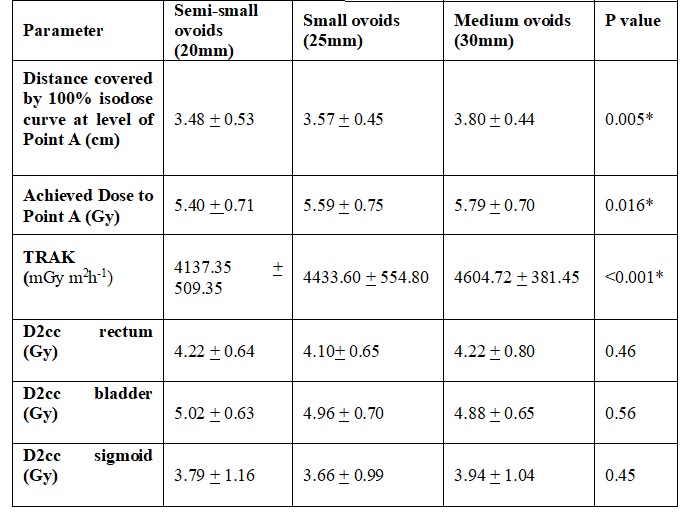Impact of Ovoid size in Intra-cavitary Brachytherapy upon target dose in patients with Cancer Cervix
Tanvir Pasha Chitradurga Abdul Razack,
India
PO-1797
Abstract
Impact of Ovoid size in Intra-cavitary Brachytherapy upon target dose in patients with Cancer Cervix
Authors: Nikhila Radhakrishna1, Tanvir Pasha C R2, Rekha Reddy Bucchapudi3, Hamsini R S4, Saritha Sunny Pullan2, Elna Jerod2, Siddanna Palled5, Thejaswini B5, Naveen Thimmaiah5, Vijayalakshmi Patil5, Lokesh Viswanath5
1Kidwai Memorial Institue of Oncology, Radiation Oncology, Bangalore, India; 2Kidwai Memorial Institute of Oncology , Radiation Oncology, Bangalore, India; 3Kidwai Memorial Institute of Oncology , Radiation Physics, Bangalore, India; 4Sri Shankara Cancer Hospital & Research Centre, Radiation Oncology, Bangalore, India; 5Kidwai Memorial Institute of Oncology, Radiation Oncology, Bangalore, India
Show Affiliations
Hide Affiliations
Purpose or Objective
In Intracavitary
Brachytherapy(ICBT) for cancer(Ca.) cervix, the largest sized ovoid that the
vagina can accommodate is used to provide maximum lateral dose throw-off to the
parametrium. However, we have observed that ovoids >2.5 cm can rarely be
accommodated in our patients. Upper
vaginal narrowing post External Beam Radiotherapy(EBRT) & racial difference in the pelvis size may be the
causative factors. Patients having a partial response to EBRT with moderate
volume residual disease are subjected to ICBT. Even with parametrial disease
limited to less than medial half of its width at BT, ICBT may be suboptimal
with undersized ovoids. Instead, they may require a combination of IC+interstitial
brachytherapy(ISBT).
We aim to determine the
most commonly used size of ovoids in ICBT among South Indian patients and measure
the maximum distance from the central uterine axis that can be covered with use
of various sizes of ovoids.
Material and Methods
Patients with Ca.cervix FIGO stage IB2 to IIIB who have
completed EBRT and ICBT for residual disease limited to medial half of
parametrium, were selected for this retrospective study. Those treated with
ISBT/ low dose rate BT were excluded. High dose rate BT was delivered using GammaMed-plus
Iridium 192 remote after-loading system with Fletcher Suit or Manchester
applicator. A dose of 6-7 Gy/3-4 Fractions was prescribed to Point A. The
target dose was optimized to cover the residual disease based on examination
under anesthesia and CT simulation respecting the dose constraints to organs at
risk (OARs).
Distance covered by 100 %
isodose curve at level of Point A, point A dose, Total Reference air kerma
(TRAK), minimum dose received by the maximally irradiated 2 cc(D2cc) of rectum,
bladder, and sigmoid colon were noted. One-way ANOVA was used for inter-group
Comparison between different sizes of ovoids. ‘p’ value ≤0.05 was considered
statistically significant*
Results
219 ICBT applications were performed for 142 patients. 115(52%) applications
with semi-small (20mm), 69(32%) with small(25mm) and 35 (16%) with medium(30mm)
sized ovoids. The mean distance of 100% isodose curve obtained by semi-small, small
and medium ovoids were 3.48 + 0.53cm, 3.57 + 0.45cm
and 3.80 + 0.44cm respectively (*p = 0.005). This reflects that
the maximum distance which can be covered on either side of central axis is
1.74cm, 1.78cm and 1.9 cm respectively. The difference in point A doses between the three ovoids was 5.40 + 0.71Gy,
5.59 + 0.75Gy and 5.79 + 0.70Gy respectively (*p=0.016). TRAK was 4137.35 +
509.35, 4433.60 + 554.80 and 4604.72 + 381.45 mGy m2 h-1for
the respective ovoids (*p < 0.001). No significant impact was noted upon OAR
doses.

Conclusion
Semi-small and small
ovoids are used in majority of South Indian patients undergoing ICBT. This may
compromise target coverage even in patients whose parametrial disease is less than 2cms from the central uterine axis. IC+ISBT may be warranted to achieve
adequate coverage of the target in such cases for optimum outcomes